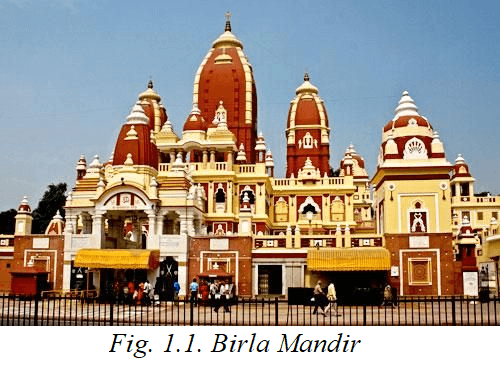Birla MandirIt is known as Birla Mandir because it was the first temple built by the Birla family. The temple was the first new Hindu temple to be erected in Delhi after the country's independence in 1947. The building of the temple began in 1933 and was completed in 1939 when it was dedicated by Mahatma Gandhi, known as the Father of the Nation. 
Near Connaught Place, Delhi's Laxminarayan Temple is a popular destination for tourists. It covers a space of 7.5 acres and has several religious and nationally significant fountains, shrines, and statues. At the temple, there is also an auditorium where religious speeches are held. Locals and visitors alike go to the Laxminarayan Temple during the Janmashtami and Diwali celebrations. Additionally, in addition to Bhagwan Sri Lakshmi-Narayana, the temple's womb, which is a sign of fertility, contains Mata Bhagwati and Shri Gauri Shankar, among others. There are sculptures of Shri Ganesh, Geeta Pillar, and Shri Bajrangbali to worship in front of the main prayer space. As soon as they pass through the enormous hall of the Geeta Bhawan, they will be able to glimpse Shri Bhagwan Yogeshwar and the Shri Ram family. The picture of Geeta Bhawan features a plethora of lovely figures, including Murali Manohar Shri Krishna, and is the most unrivaled beauty in the world. The large garden that has been created in conjunction with the temple only serves to pique the interest of youngsters in this location. As a result, children's interest in animals like cheetahs and bears has grown even more. There are now even more options for kids to play with than there were before. This temple garden also has the Artificial Cave, which may be viewed there. A Shiva temple has also been built near the cave, with the entrance leading through the demon's massive mouth. HistoryThis magnificent edifice, also known as the Birla Temple, was erected by the Birla family, a well-known business family in India. The building of the temple began in 1933 when BD Birla and his son Jugal Kishore Birla began work on the project together. Maharaj Udaybhanu Singh is credited with laying the foundation stone for this well-known temple. Throughout the construction of the temple, Pandit Vishwanath Shastri served as the guide. As soon as the construction was done, Swami Keshav Nandji conducted the final ritual and Yagna, which marked the completion of the project. The temple is said to have been opened by Mahatma Gandhi, who stipulated that access into the temple would not be restricted based on the caste of the pilgrims, which was a first in India. It was his insistence that devotees of all castes should be permitted to worship at the temple, regardless of whether he was a brahmin or a shudra "lower caste". StructureBeyond its religious importance, the Laxminarayan Temple is a visually spectacular piece of architecture. A leading figure in the Modern Indian Architecture Movement, Sris Chandra Chatterjee, designed the temple. It was an exciting period in the nation. The Swadeshi movement was widespread throughout the nation. There is a lot to learn from Birla Temple's architecture about its era. The Swadeshi movement of the early twentieth century is abundantly seen in the construction of the temple. The monument contains several quotations from canonical literature. Chatterjee has a reputation for having a forward-looking perspective. Chatterjee used cutting-edge technology and materials in the monument's construction while still honoring the site's religious and national significance. Built-in the Nagara architectural style, the Birla temple has three floors. The temple's walls are covered with carvings depicting scenes from the current Kalpa yuga's golden era. A large group of Benaras artists had gathered to carve the temple's icons, led by Acharya Vishwanath Shastri. Marble stone from Jaipur is used in the creation of these symbols. Other than that, the temple has Kota stonework that was transported from areas like Agra and Jaisalmer. The temple's Shikara, which sits above the sanctum sanctorum, is a major draw. It stands at the height of roughly 160 feet. When the sun rises, the temple is awe-inspiringly gorgeous. Some frescoes also decorate the top of the plinth where it sits. Lord Krishna is the only focus of the Geeta Bhavan, a building to the north of the temple. There are more temples devoted to Lord Shiva, Buddha, and Krishna in addition to the main temple. This is a must-see for everyone who appreciates fine architecture. The place is aesthetic appeal is heightened by its man-made environment and flowing waterfalls. Lord Vishnu and Goddess Laxmi are housed in the main shrine. There are Aarti periods in the morning and evening, and the hall can accommodate a large number of people. All year long, devotees go to the side shrines dedicated to the god Shiva and Krishna. In addition, on the left side of the temple, Shikhar is a temple dedicated to Goddess Durga, who is considered the embodiment of power. During the Navratri celebration, this temple attracts tourists from all around the globe. TimingsThe Birla Mandir opens its doors at 4:30 a.m. It is open till 1:30 p.m. on weekdays and on weekends. After 2:30 p.m., the temple will be open to visitors again. The Birla Temple closes its doors at 9:00 p.m. Visits to the temple are free of charge, as is parking. The use of cameras is not permitted within the shrine.
Next TopicPrem Mandir
|
 For Videos Join Our Youtube Channel: Join Now
For Videos Join Our Youtube Channel: Join Now
Feedback
- Send your Feedback to [email protected]
Help Others, Please Share










